Services
We provide a variety of Oral and Maxillofacial services for Northern Nevada, Lake Tahoe, and the surrounding areas. Our services include Dental Implants, Wisdom Teeth, Bone Grafting, and Oral Pathology. Please contact us anytime with questions about our procedures and how we can help you with your dental health.
Why Dental Implants?
Dental implants have enhanced the quality of life for thousands of people throughout the world, improving overall health and well being and restoring the confidence that comes from a natural smile and appearance. This “state-of-the-art” dental technology makes it possible to restore the mouth as closely as possible to its natural state and eliminate the need to cut down adjacent teeth for bridgework.
Dental implants are basically substitute tooth roots, used to replace natural tooth roots in areas of the mouth where teeth are missing.
The reason it is so important to replace the tooth root and not just the visible part of the tooth (crown) is that natural tooth roots, which are embedded in the bone, preserve the bone. When teeth are missing, the bone that previously supported those teeth melts away or deteriorates. This process is called bone resorption.
However, the bone can be preserved by replacing missing tooth roots with dental implants. Since the bone actually forms a strong bond to the implants, they can serve virtually the same functions as natural tooth roots: a strong foundation for biting and chewing and stimulation for the bone to preserve facial structures. Our website provides the answers to questions that our patients typically ask about dental implant treatment. For more comprehensive information please visit www.missingteeth.org.
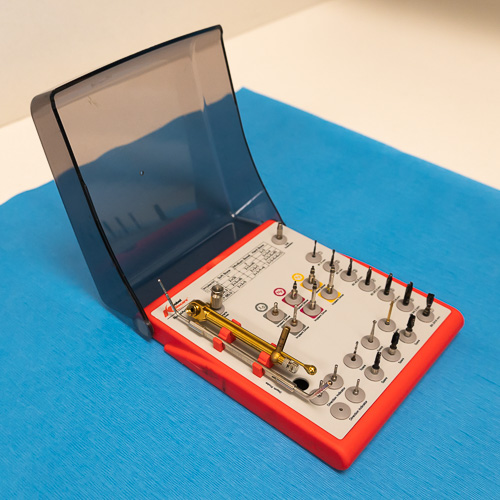
nobel biocare surgical implant kit,
Benefits of Dental Implants
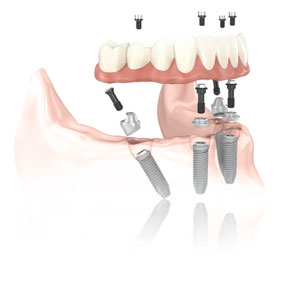
Example of the pieces that encompass a full lower dental implant.
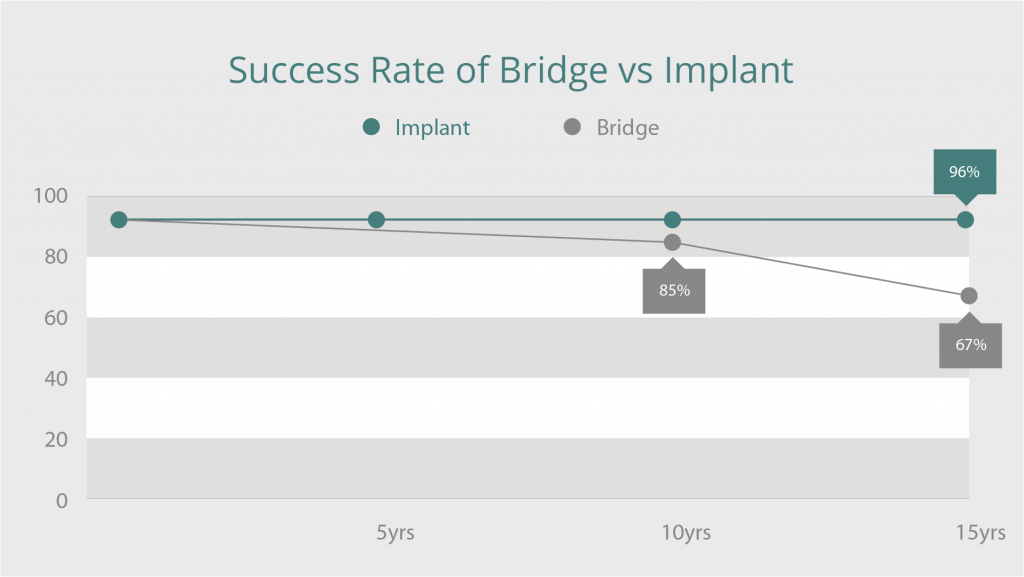
This graph displays how implants have better long-term success that bridges.
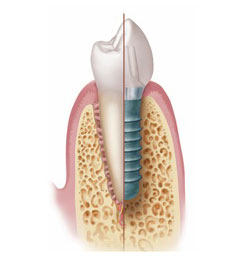
Comparison of a normal tooth with a dental implant.
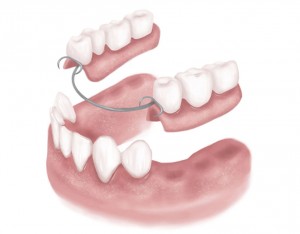
Dental implants preserve bone and support replacement teeth.
What is 'All-on-4'?
The Nobel Biocare All-on-4 system is an exciting breakthrough in the treatment of patients who are missing all their teeth in the upper jaw, lower jaw, or both. Because all the missing teeth in the arch are connected to only four implants, replacing your denture with an implant supported set of teeth is far less costly. Even better all the procedures including attachment of the teeth to the implants happens in one morning. Dr. Gray works with select local dentists. Your dentist and Dr. Gray work together with a laboratory technician to complete your initial care in just one morning.
Once teeth are lost bone begins to dissolve and your upper and lower jaw become smaller, and smaller. As time goes by this is why your denture becomes more and more difficult to wear.
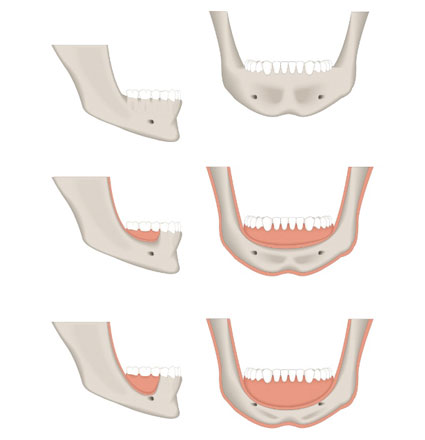
THIS DEPICTION SHOWS THE BONE LOSS THAT OCCURS ONCE TEETH HAVE BEEN LOST.
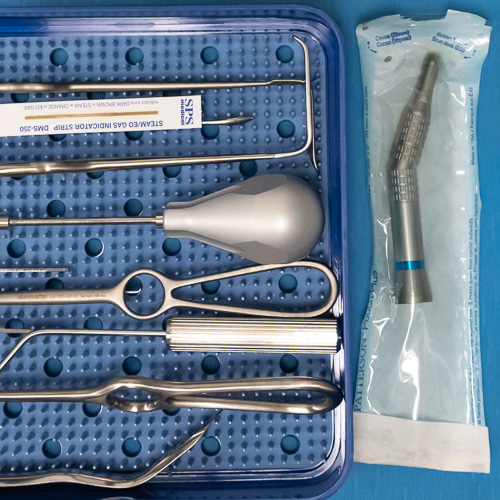
Carson valley oral surgery offers the all-in-4 zygomatic procedure as shown by this extensive surgical kit.
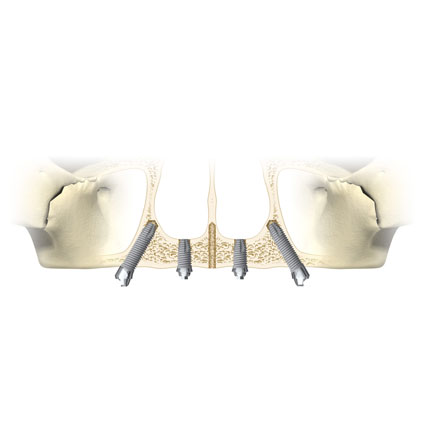
Once teeth are lost bone begins to dissolve and your upper and lower jaw become smaller, and smaller. As time goes by this is why your denture becomes more and more difficult to wear.
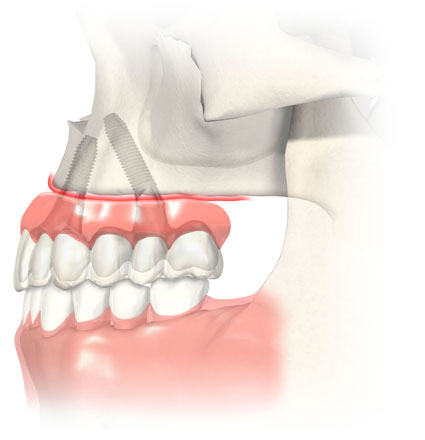
This image depicts the All-on-4 system, side view.
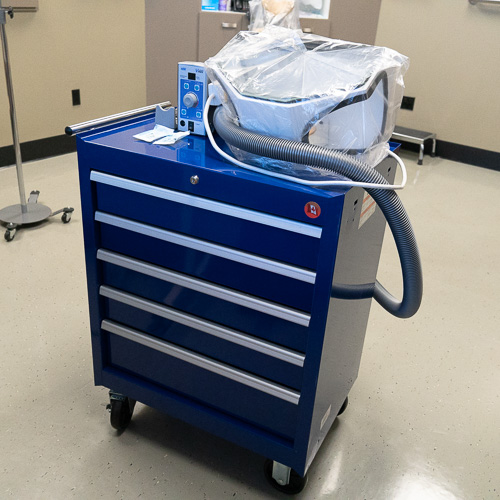
cart filled with dental equipment used for all-in-4 procedures.
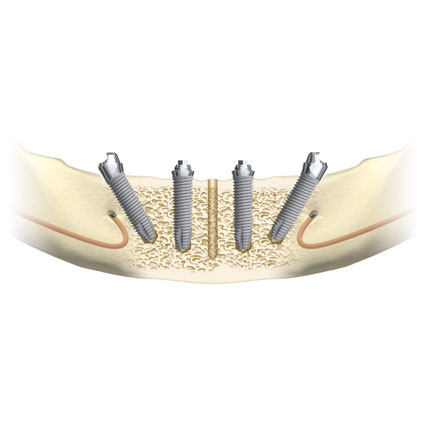
This image depicts the All-on-4 system in the lower jaw, or also known as the mandible.
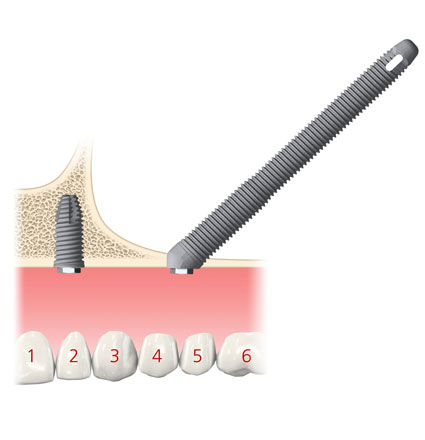
For patients will extremely limited bone, very specialized implants called Zygomatic Implants can be used as part of the All-on-4 system.
How Does Implant Placement Work?
Based on an individual treatment plan and at Dr. Gray’s discretion, implants may be possible at the time of extraction.
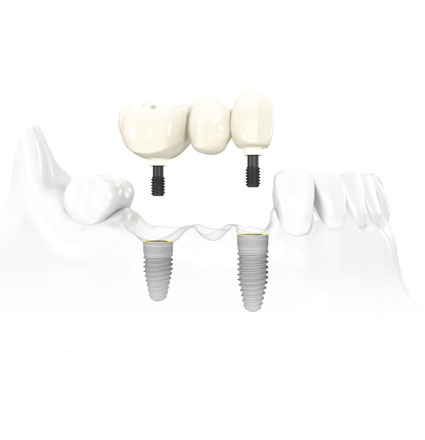
THIS IMAGE SHOWS HOW A DENTAL ROOT IMPLANT LOOKS AND FUNCTIONS LIKE A NORMAL TOOTH.
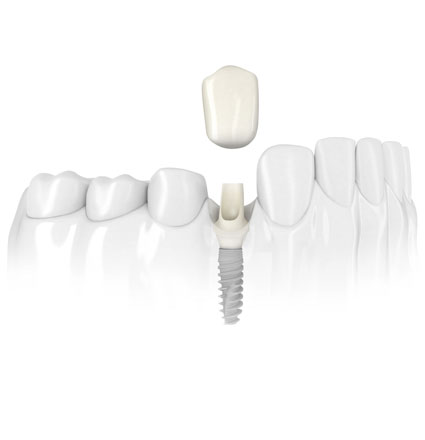
IMPLANTS CAN ALSO SUPPORT MULTIPLE MISSING TEETH IN A BRIDGE STRUCTURE.
Your 3rd Molars
The average adult has 32 teeth by age 18 — 16 teeth on the top and 16 teeth on the bottom. Each tooth in the mouth has a specific name and function. The teeth in the front of the mouth (incisors, canine and bicuspid teeth) are ideal for grasping and biting food into smaller pieces while the back teeth, or molar teeth, are used to grind food up into a consistency suitable for swallowing.
However, the average mouth is made to hold only 28 teeth. It can be painful when 32 teeth try to fit in a mouth that holds only 28 teeth. These four other teeth are your Third Molars, also known as “wisdom teeth.”
The average adult has 32 teeth by age 18 — 16 teeth on the top and 16 teeth on the bottom. Each tooth in the mouth has a specific name and function. The teeth in the front of the mouth (incisors, canine and bicuspid teeth) are ideal for grasping and biting food into smaller pieces while the back teeth, or molar teeth, are used to grind food up into a consistency suitable for swallowing.
However, the average mouth is made to hold only 28 teeth. It can be painful when 32 teeth try to fit in a mouth that holds only 28 teeth. These four other teeth are your Third Molars, also known as “wisdom teeth.”
Why Should I Have My Wisdom Teeth Removed?
Wisdom teeth are the last teeth to erupt within the mouth. When they align properly and gum tissue is healthy, wisdom teeth do not have to be removed. Unfortunately, this does not generally happen. The extraction of wisdom teeth is necessary when they are prevented from properly erupting within the mouth. They may grow sideways, partially emerge from the gum, and even remain trapped beneath the gum and bone. Impacted teeth can take many positions in the bone as they attempt to find a pathway that will allow them to erupt successfully.
These poorly positioned impacted teeth can cause many problems. When they are partially erupted, the opening around the tooth allows bacteria to grow and will eventually cause an infection. The result: swelling, stiffness, pain and illness. The pressure from the erupting wisdom tooth may move other teeth and disrupt the orthodontic or natural alignment of teeth. The most serious problem occurs when tumors or cysts form around the impacted wisdom tooth, resulting in the destruction of the jawbone and healthy teeth. Removal of the offending impacted tooth or teeth usually resolves these problems. Early removal is recommended to avoid such future problems and to decrease the surgical risk involved with the procedure.
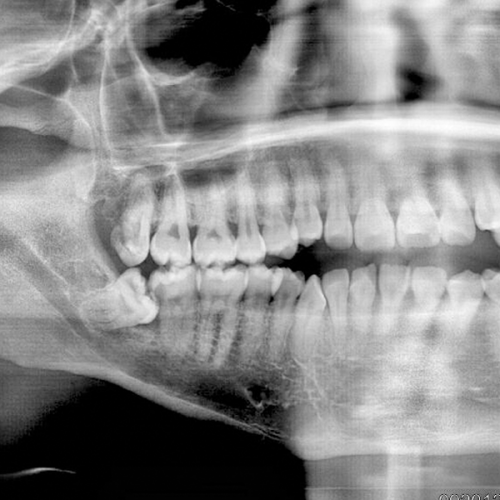
X-RAY EXAMPLE OF IMPACTED WISDOM TEETH WHICH NEED TO BE EXTRACTED.
Oral Examination
With an oral examination and x-rays of the mouth, Dr. Gray can evaluate the position of the wisdom teeth and predict if there may be present or future problems. Studies have shown that early evaluation and treatment result in a superior outcome for the patient. Patients are generally first evaluated in the mid- teenage years by their dentist orthodontist or by an oral and maxillofacial surgeon.
All outpatient surgery is performed under appropriate anesthesia to maximize patient comfort. Dr. Gray has the training, license, and experience to provide various types of anesthesia to allow patients to select the best alternative. These services are provided in an environment of optimum safety, utilizing modern monitoring equipment and staff experienced in anesthesia techniques.
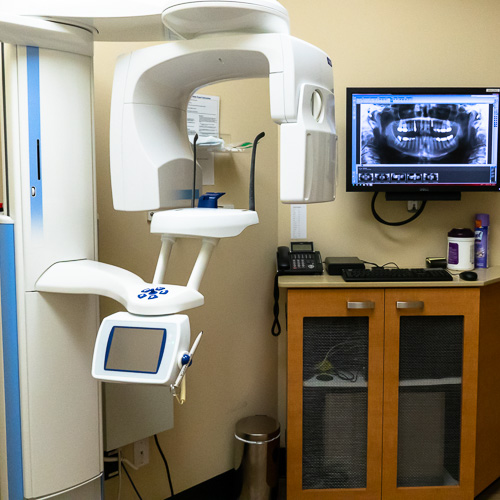
THIS IS THE X-RAY CONSULTATION ROOM WHERE YOU WILL START YOUR FIRST APPOINTMENT. DR. GRAY WILL ANALYZE YOUR X-RAY TO DETERMINE WHAT IS BEST FOR YOUR DENTAL OR SURGICAL NEEDS.
What is Bone Grafting?
Many times due to progressive disease, infection, or trauma, bone and soft tissue are lost in areas around the teeth. Bone resorption or deterioration occurs naturally when teeth are lost or removed unless dental implants are placed to preserve the bone.
Fortunately for those patients who have lost bone, it is possible to augment or replace the bone with grafting techniques and successfully place implants. Any defects in the bone in the front of the mouth can be corrected to create the proper facial contours and tissue support necessary to achieve optimal esthetic results.
If small defects are present in the desired implant location, a bone graft with either real or synthetic bone is used to fill in the defects. Since gum tissue grows faster than bone and will in essence invade the bone graft, causing it to shrink, a thin collagen membrane is used to cover the graft to prevent the gum tissue from growing into the area. Sometimes the bone graft can be accomplished at the same time as implant placement. This type of graft takes the same time to heal as it takes for the bone to remodel after the implants have been placed.
If there is a substantial amount of bone loss, which prevents the placement of dental implants, an actual block of bone can be removed from the chin or behind the lower back teeth and transplanted to the area in need. These “blocks” of bone are held in place using small titanium screws to allow for healing. They will often be covered with a thin collagen membrane to aid the healing process. These grafts typically require four to six months to heal and form new bone identical to the shape of the transplanted block. Implants can then be placed securely in this bone. It will usually take another three to four months for the bone to remodel around the implants.
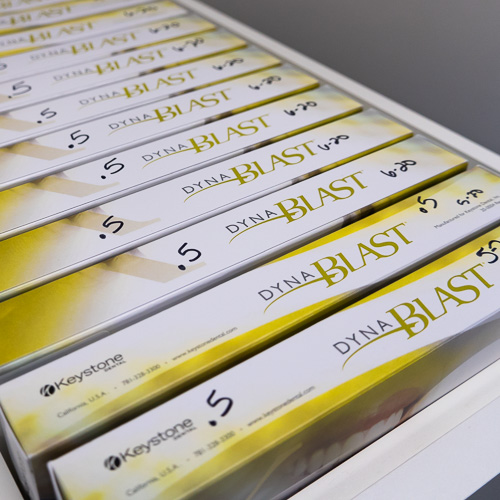
BONE GRAFTING SUPPLY. DYNA BLAST IS USED TO INCREASE BONE VOLUMES.
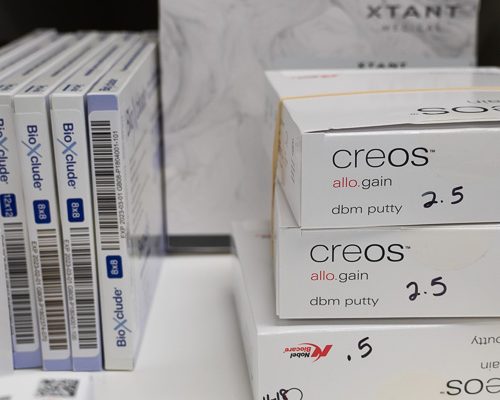
WE KEEP A CONSTANT STOCK OF HIGH QUALITY BONE GRAFTING MATERIALS./h6>
Surgical Removal of Teeth
Many simple extractions can be performed by a general dentist. However, since an oral surgeon has special training, dentists will usually refer patients for the removal of damaged, impacted, or severely decayed teeth, including wisdom teeth.
Patients who are considering dental implants are also referred to an oral surgeon so that the teeth can be removed with techniques that preserve the bone, which creates a better site for implant placement.
In addition, patients who would be more comfortable receiving sedation or general anesthesia during surgical procedures are usually referred to an oral surgeon for surgical removal of teeth.

Removal of Wisdom Teeth
Third molars are commonly referred to as wisdom teeth. The wisdom teeth are located in the back of the mouth, one in each quadrant behind the second or 12-year molars
Although most people develop 32 permanent teeth, often the jaws are not large enough to accommodate all four wisdom teeth. When inadequate space prevents the teeth from erupting into the proper position, they are “impacted”. An impacted tooth remains embedded in the gum tissue or bone beyond its normal eruption time (pushing through the gum tissue into place). Because they are the last teeth to emerge, the most common teeth to become impacted are the wisdom teeth, which normally emerge between the ages of 17 and 21.
As the wisdom teeth develop, the roots continue to grow longer and the jawbone becomes denser. As people age, it becomes more difficult to remove the teeth and complications are more likely. In addition, the problems associated with impacted teeth tend to occur with increasing frequency after the age of 30. Therefore, it is usually recommended to have wisdom teeth removed during the teenage years or early twenties before the root structure is fully developed.
Some of the problems that can develop from partially impacted teeth include pain, infection, crowding, and damage to adjacent teeth. More serious problems, such as damage to the jawbone caused by the formation of cysts, can occur with completely impacted teeth. Surgeons generally recommend the removal of wisdom teeth to prevent these problems from developing.
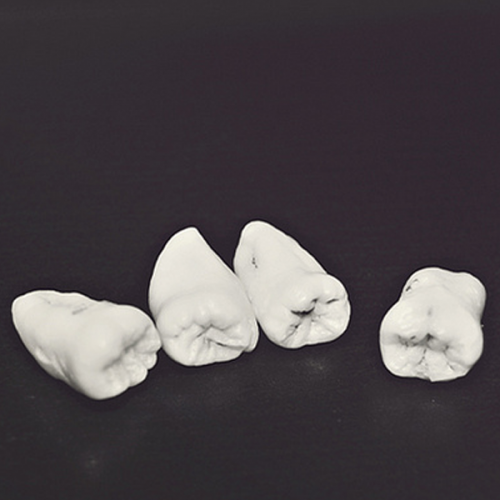

Oral Diseases and Infections
The inside of the mouth is normally lined with a special type of skin (mucosa) that is smooth and coral pink in color. Any alteration in this appearance could be a warning sign for a pathological process. The most serious of these is oral cancer.
The following can be signs at the beginning of a pathologic process or cancerous growth:
These changes can be detected on the lips, cheeks, palate, and gum tissue around the teeth, tongue, face, and/or neck. Pain does not always occur with pathology and, curiously, is not often associated with oral cancer. However, any patient with facial or oral pain without an obvious cause may also be at risk for oral cancer. Cancer screening and biopsy of questionable tissue is a routine part of the practice. Fortunately, bones and soft tissues damaged by oral cancer can be repaired or reconstructed surgically. Dr. Gray also treats infections of the mouth, jaw and neck.
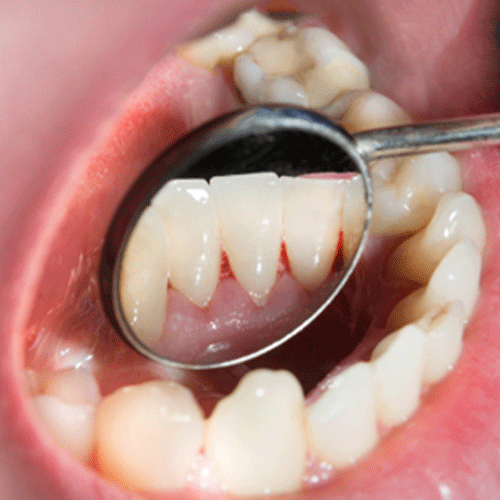

Bone Preservation and Augmentation
Many times due to progressive disease, infection, or trauma, bone and soft tissues are lost in areas around the teeth. This process is accelerated when teeth are removed and nothing is done to replace the stimulation that tooth root provides to preserve the jawbone. This is extremely prevalent in the front of the upper jaw where bone loss and shrinking gum tissue can be seen when we smile.
Placement of dental implants prevents the defect that would normally develop when teeth are missing. And, there are techniques to replace bone and gum tissue in areas where it has been lost. Depending on the size of the defect, and the location within the mouth, this can be done easily in the office, often at the same time as placement of dental implants.
Patients who are considering dental implants are also referred to an oral surgeon so that the teeth can be removed with techniques that preserve the bone, which creates a better site for implant placement.
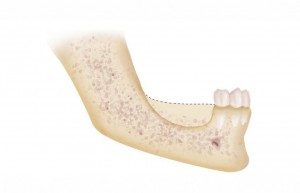
Example of Bone resorption that occurs when teeth are missing.

Anesthesia and Pain Relief
For your comfort, surgery can be performed under local anesthesia, fully awake; under general anesthesia, fully asleep; or with light sedation combined with local anesthesia. What method of treatment will work best for you is something that you and Dr. Gray will discuss at the consult appointment.
As part of his residency training Dr. Gray worked as an anesthesia resident at Oregon Health and Science University, in Portland, Oregon. Our staff is highly trained and certified in outpatient anesthesia and our office has modern operating rooms equipped with state of the art monitoring equipment to allow for safe anesthesia delivery.
Dr. Gray is an Anesthesia Examiner for the Nevada State Board of Dental Examiners. In this role he visits other offices that offer, or wish to offer anesthesia services. He insures that the office has all of the emergency equipment required, insures that people on site know how to use the equipment. He reviews all the available medications insuring that the person requesting an anesthesia license knows the proper doses and usage. Dr. Gray even checks to make sure nothing is expired. Following this he watches a surgery, and takes the doctor and staff through emergency scenarios.
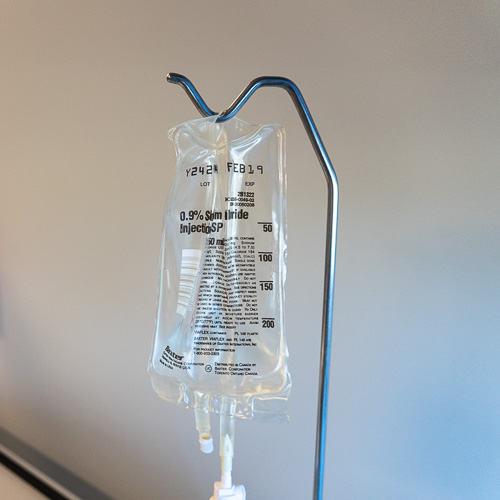
What is the pathological process?
The inside of the mouth is normally lined with a special type of skin (mucosa) that is smooth and coral pink in color. Any alteration in this appearance could be a warning sign for a pathological process. The most serious of these is oral cancer.
Detect Oral Cancer
These changes can be detected on the lips, cheeks, palate, and gum tissue around the teeth, tongue, face, and/or neck. Pain does not always occur with pathology and, curiously, is not often associated with oral cancer. However, any patient with facial and/or oral pain without an obvious cause or reason may also be at risk for oral cancer.
We would recommend performing an oral cancer self-examination monthly and remember that your mouth is one of your body’s most important warning systems. Do not ignore suspicious lumps or sores. Please contact us so we may help.
The following can be signs at the beginning of a pathologic process or cancerous growth:
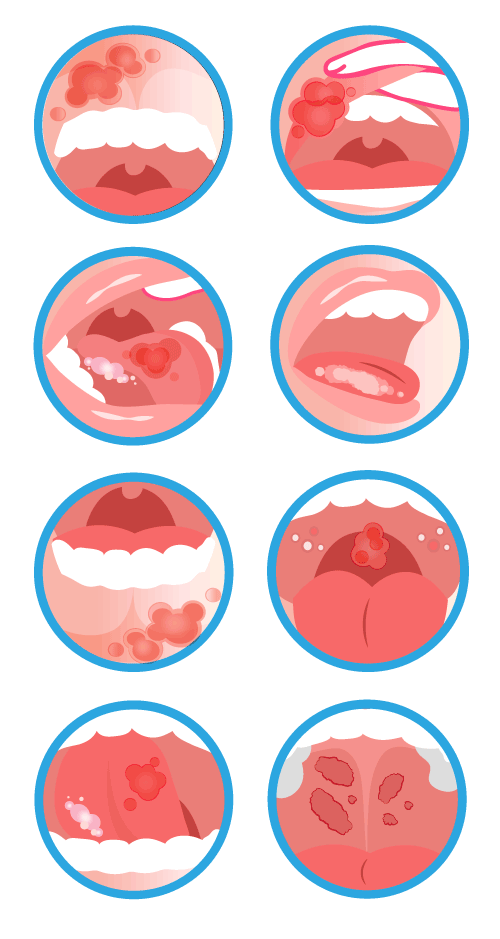
Example of different patches or sores that may be present with oral disease.
Anesthesia and IV Sedation
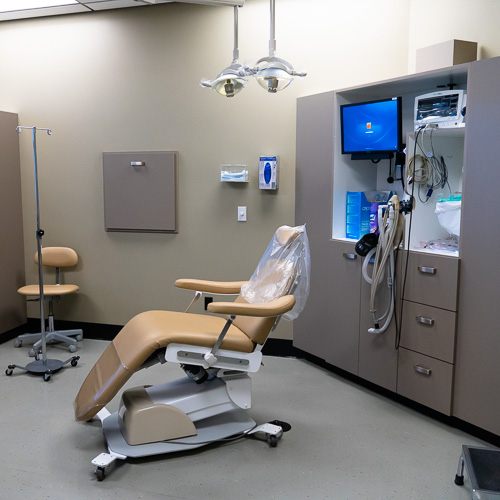
ONE OF THE SURGICAL ROOMS AT CARSON VALLEY ORAL SURGERY. DURING YOUR PROCEDURE, THERE WILL BE 3 NURSES PRESENT TO ASSIST DR. GRAY.
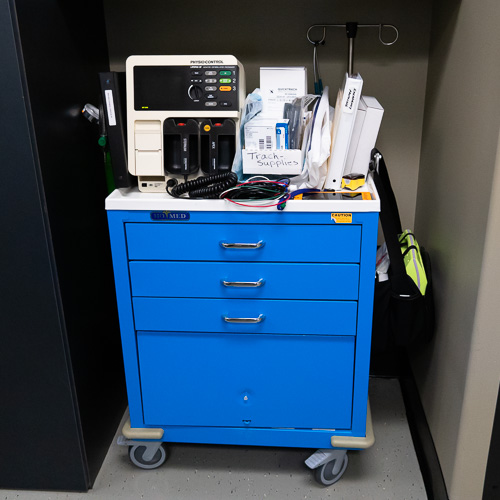
THE EMERGENCY PREPAREDNESS CART AT CVOS. THIS CART IS FILLED WITH UP-TO-DATE ANESTHESIA AND TOOLS FOR ANY TYPE OF EMERGENCY THAT MAY OCCUR.
- Dental Implants
-
Why Dental Implants?
Dental implants have enhanced the quality of life for thousands of people throughout the world, improving overall health and well being and restoring the confidence that comes from a natural smile and appearance. This “state-of-the-art” dental technology makes it possible to restore the mouth as closely as possible to its natural state and eliminate the need to cut down adjacent teeth for bridgework.
Dental implants are basically substitute tooth roots, used to replace natural tooth roots in areas of the mouth where teeth are missing.
The reason it is so important to replace the tooth root and not just the visible part of the tooth (crown) is that natural tooth roots, which are embedded in the bone, preserve the bone. When teeth are missing, the bone that previously supported those teeth melts away or deteriorates. This process is called bone resorption.
However, the bone can be preserved by replacing missing tooth roots with dental implants. Since the bone actually forms a strong bond to the implants, they can serve virtually the same functions as natural tooth roots: a strong foundation for biting and chewing and stimulation for the bone to preserve facial structures. Our website provides the answers to questions that our patients typically ask about dental implant treatment. For more comprehensive information please visit www.missingteeth.org.

nobel biocare surgical implant kit,
Benefits of Dental Implants

Example of the pieces that encompass a full lower dental implant.

This graph displays how implants have better long-term success that bridges.

Comparison of a normal tooth with a dental implant.

Dental implants preserve bone and support replacement teeth.
- Teeth in a Day
-
What is 'All-on-4'?
The Nobel Biocare All-on-4 system is an exciting breakthrough in the treatment of patients who are missing all their teeth in the upper jaw, lower jaw, or both. Because all the missing teeth in the arch are connected to only four implants, replacing your denture with an implant supported set of teeth is far less costly. Even better all the procedures including attachment of the teeth to the implants happens in one morning. Dr. Gray works with select local dentists. Your dentist and Dr. Gray work together with a laboratory technician to complete your initial care in just one morning.
Once teeth are lost bone begins to dissolve and your upper and lower jaw become smaller, and smaller. As time goes by this is why your denture becomes more and more difficult to wear.

THIS DEPICTION SHOWS THE BONE LOSS THAT OCCURS ONCE TEETH HAVE BEEN LOST.

Carson valley oral surgery offers the all-in-4 zygomatic procedure as shown by this extensive surgical kit.

Once teeth are lost bone begins to dissolve and your upper and lower jaw become smaller, and smaller. As time goes by this is why your denture becomes more and more difficult to wear.

This image depicts the All-on-4 system, side view.

cart filled with dental equipment used for all-in-4 procedures.

This image depicts the All-on-4 system in the lower jaw, or also known as the mandible.

For patients will extremely limited bone, very specialized implants called Zygomatic Implants can be used as part of the All-on-4 system.
- Implant Placement
-
How Does Implant Placement Work?
Based on an individual treatment plan and at Dr. Gray’s discretion, implants may be possible at the time of extraction.

THIS IMAGE SHOWS HOW A DENTAL ROOT IMPLANT LOOKS AND FUNCTIONS LIKE A NORMAL TOOTH.

IMPLANTS CAN ALSO SUPPORT MULTIPLE MISSING TEETH IN A BRIDGE STRUCTURE.
- Wisdom Teeth
-
Your 3rd Molars
The average adult has 32 teeth by age 18 — 16 teeth on the top and 16 teeth on the bottom. Each tooth in the mouth has a specific name and function. The teeth in the front of the mouth (incisors, canine and bicuspid teeth) are ideal for grasping and biting food into smaller pieces while the back teeth, or molar teeth, are used to grind food up into a consistency suitable for swallowing.
However, the average mouth is made to hold only 28 teeth. It can be painful when 32 teeth try to fit in a mouth that holds only 28 teeth. These four other teeth are your Third Molars, also known as “wisdom teeth.”
The average adult has 32 teeth by age 18 — 16 teeth on the top and 16 teeth on the bottom. Each tooth in the mouth has a specific name and function. The teeth in the front of the mouth (incisors, canine and bicuspid teeth) are ideal for grasping and biting food into smaller pieces while the back teeth, or molar teeth, are used to grind food up into a consistency suitable for swallowing.
However, the average mouth is made to hold only 28 teeth. It can be painful when 32 teeth try to fit in a mouth that holds only 28 teeth. These four other teeth are your Third Molars, also known as “wisdom teeth.”
Why Should I Have My Wisdom Teeth Removed?
Wisdom teeth are the last teeth to erupt within the mouth. When they align properly and gum tissue is healthy, wisdom teeth do not have to be removed. Unfortunately, this does not generally happen. The extraction of wisdom teeth is necessary when they are prevented from properly erupting within the mouth. They may grow sideways, partially emerge from the gum, and even remain trapped beneath the gum and bone. Impacted teeth can take many positions in the bone as they attempt to find a pathway that will allow them to erupt successfully.
These poorly positioned impacted teeth can cause many problems. When they are partially erupted, the opening around the tooth allows bacteria to grow and will eventually cause an infection. The result: swelling, stiffness, pain and illness. The pressure from the erupting wisdom tooth may move other teeth and disrupt the orthodontic or natural alignment of teeth. The most serious problem occurs when tumors or cysts form around the impacted wisdom tooth, resulting in the destruction of the jawbone and healthy teeth. Removal of the offending impacted tooth or teeth usually resolves these problems. Early removal is recommended to avoid such future problems and to decrease the surgical risk involved with the procedure.

X-RAY EXAMPLE OF IMPACTED WISDOM TEETH WHICH NEED TO BE EXTRACTED.
Oral Examination
With an oral examination and x-rays of the mouth, Dr. Gray can evaluate the position of the wisdom teeth and predict if there may be present or future problems. Studies have shown that early evaluation and treatment result in a superior outcome for the patient. Patients are generally first evaluated in the mid- teenage years by their dentist orthodontist or by an oral and maxillofacial surgeon.
All outpatient surgery is performed under appropriate anesthesia to maximize patient comfort. Dr. Gray has the training, license, and experience to provide various types of anesthesia to allow patients to select the best alternative. These services are provided in an environment of optimum safety, utilizing modern monitoring equipment and staff experienced in anesthesia techniques.

THIS IS THE X-RAY CONSULTATION ROOM WHERE YOU WILL START YOUR FIRST APPOINTMENT. DR. GRAY WILL ANALYZE YOUR X-RAY TO DETERMINE WHAT IS BEST FOR YOUR DENTAL OR SURGICAL NEEDS.
- Bone Grafting
-
What is Bone Grafting?
Many times due to progressive disease, infection, or trauma, bone and soft tissue are lost in areas around the teeth. Bone resorption or deterioration occurs naturally when teeth are lost or removed unless dental implants are placed to preserve the bone.
Fortunately for those patients who have lost bone, it is possible to augment or replace the bone with grafting techniques and successfully place implants. Any defects in the bone in the front of the mouth can be corrected to create the proper facial contours and tissue support necessary to achieve optimal esthetic results.
If small defects are present in the desired implant location, a bone graft with either real or synthetic bone is used to fill in the defects. Since gum tissue grows faster than bone and will in essence invade the bone graft, causing it to shrink, a thin collagen membrane is used to cover the graft to prevent the gum tissue from growing into the area. Sometimes the bone graft can be accomplished at the same time as implant placement. This type of graft takes the same time to heal as it takes for the bone to remodel after the implants have been placed.
If there is a substantial amount of bone loss, which prevents the placement of dental implants, an actual block of bone can be removed from the chin or behind the lower back teeth and transplanted to the area in need. These “blocks” of bone are held in place using small titanium screws to allow for healing. They will often be covered with a thin collagen membrane to aid the healing process. These grafts typically require four to six months to heal and form new bone identical to the shape of the transplanted block. Implants can then be placed securely in this bone. It will usually take another three to four months for the bone to remodel around the implants.

BONE GRAFTING SUPPLY. DYNA BLAST IS USED TO INCREASE BONE VOLUMES.

WE KEEP A CONSTANT STOCK OF HIGH QUALITY BONE GRAFTING MATERIALS./h6>
- Oral Surgery
-
Surgical Removal of Teeth
Many simple extractions can be performed by a general dentist. However, since an oral surgeon has special training, dentists will usually refer patients for the removal of damaged, impacted, or severely decayed teeth, including wisdom teeth.
Patients who are considering dental implants are also referred to an oral surgeon so that the teeth can be removed with techniques that preserve the bone, which creates a better site for implant placement.
In addition, patients who would be more comfortable receiving sedation or general anesthesia during surgical procedures are usually referred to an oral surgeon for surgical removal of teeth.

Removal of Wisdom Teeth
Third molars are commonly referred to as wisdom teeth. The wisdom teeth are located in the back of the mouth, one in each quadrant behind the second or 12-year molars
Although most people develop 32 permanent teeth, often the jaws are not large enough to accommodate all four wisdom teeth. When inadequate space prevents the teeth from erupting into the proper position, they are “impacted”. An impacted tooth remains embedded in the gum tissue or bone beyond its normal eruption time (pushing through the gum tissue into place). Because they are the last teeth to emerge, the most common teeth to become impacted are the wisdom teeth, which normally emerge between the ages of 17 and 21.
As the wisdom teeth develop, the roots continue to grow longer and the jawbone becomes denser. As people age, it becomes more difficult to remove the teeth and complications are more likely. In addition, the problems associated with impacted teeth tend to occur with increasing frequency after the age of 30. Therefore, it is usually recommended to have wisdom teeth removed during the teenage years or early twenties before the root structure is fully developed.
Some of the problems that can develop from partially impacted teeth include pain, infection, crowding, and damage to adjacent teeth. More serious problems, such as damage to the jawbone caused by the formation of cysts, can occur with completely impacted teeth. Surgeons generally recommend the removal of wisdom teeth to prevent these problems from developing.


Oral Diseases and Infections
The inside of the mouth is normally lined with a special type of skin (mucosa) that is smooth and coral pink in color. Any alteration in this appearance could be a warning sign for a pathological process. The most serious of these is oral cancer.
The following can be signs at the beginning of a pathologic process or cancerous growth:
These changes can be detected on the lips, cheeks, palate, and gum tissue around the teeth, tongue, face, and/or neck. Pain does not always occur with pathology and, curiously, is not often associated with oral cancer. However, any patient with facial or oral pain without an obvious cause may also be at risk for oral cancer. Cancer screening and biopsy of questionable tissue is a routine part of the practice. Fortunately, bones and soft tissues damaged by oral cancer can be repaired or reconstructed surgically. Dr. Gray also treats infections of the mouth, jaw and neck.


Bone Preservation and Augmentation
Many times due to progressive disease, infection, or trauma, bone and soft tissues are lost in areas around the teeth. This process is accelerated when teeth are removed and nothing is done to replace the stimulation that tooth root provides to preserve the jawbone. This is extremely prevalent in the front of the upper jaw where bone loss and shrinking gum tissue can be seen when we smile.
Placement of dental implants prevents the defect that would normally develop when teeth are missing. And, there are techniques to replace bone and gum tissue in areas where it has been lost. Depending on the size of the defect, and the location within the mouth, this can be done easily in the office, often at the same time as placement of dental implants.
Patients who are considering dental implants are also referred to an oral surgeon so that the teeth can be removed with techniques that preserve the bone, which creates a better site for implant placement.

Example of Bone resorption that occurs when teeth are missing.

Anesthesia and Pain Relief
For your comfort, surgery can be performed under local anesthesia, fully awake; under general anesthesia, fully asleep; or with light sedation combined with local anesthesia. What method of treatment will work best for you is something that you and Dr. Gray will discuss at the consult appointment.
As part of his residency training Dr. Gray worked as an anesthesia resident at Oregon Health and Science University, in Portland, Oregon. Our staff is highly trained and certified in outpatient anesthesia and our office has modern operating rooms equipped with state of the art monitoring equipment to allow for safe anesthesia delivery.
Dr. Gray is an Anesthesia Examiner for the Nevada State Board of Dental Examiners. In this role he visits other offices that offer, or wish to offer anesthesia services. He insures that the office has all of the emergency equipment required, insures that people on site know how to use the equipment. He reviews all the available medications insuring that the person requesting an anesthesia license knows the proper doses and usage. Dr. Gray even checks to make sure nothing is expired. Following this he watches a surgery, and takes the doctor and staff through emergency scenarios.

- Oral Pathology
-
What is the pathological process?
The inside of the mouth is normally lined with a special type of skin (mucosa) that is smooth and coral pink in color. Any alteration in this appearance could be a warning sign for a pathological process. The most serious of these is oral cancer.
Detect Oral Cancer
These changes can be detected on the lips, cheeks, palate, and gum tissue around the teeth, tongue, face, and/or neck. Pain does not always occur with pathology and, curiously, is not often associated with oral cancer. However, any patient with facial and/or oral pain without an obvious cause or reason may also be at risk for oral cancer.
We would recommend performing an oral cancer self-examination monthly and remember that your mouth is one of your body’s most important warning systems. Do not ignore suspicious lumps or sores. Please contact us so we may help.
The following can be signs at the beginning of a pathologic process or cancerous growth:

Example of different patches or sores that may be present with oral disease.
- Anesthesia
-
Anesthesia and IV Sedation
Dr. Gray works with 3 assistants during your surgery. This is commonly referred to as the “Team of 4” surgical model. One surgical assistant works with Dr. Gray on completing the case. A second surgical assistant holds the patients lower jaw to help decrease the amount of TMJ discomfort encountered after oral surgery. The third assistant is not directly involved with the case and is referred to as the “circulator”. This assistant can immediately get additional items for the surgeon without concern for cross contamination. This circulating assistant is used to prevent bacteria from being transmitted from the patient to drawers, handles and any other items that could be touched while accessing the needed item.
ONE OF THE SURGICAL ROOMS AT CARSON VALLEY ORAL SURGERY. DURING YOUR PROCEDURE, THERE WILL BE 3 NURSES PRESENT TO ASSIST DR. GRAY.
Dr. Gray has been an anesthesia examiner for the Nevada Board of Dental Examiners for many years. In this role he insures that other offices in Nevada have all of the emergency equipment required by state statute, and all the medications on hand that would be required for use in an emergency. He the observes the surgeon as he/she operates on a patient. Then takes the surgeon through 18 different emergency scenarios, asking questions as to what the surgeons response would be to different emergency situations.
THE EMERGENCY PREPAREDNESS CART AT CVOS. THIS CART IS FILLED WITH UP-TO-DATE ANESTHESIA AND TOOLS FOR ANY TYPE OF EMERGENCY THAT MAY OCCUR.